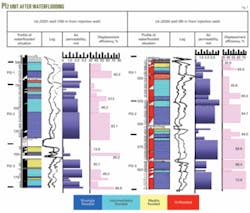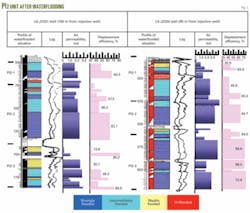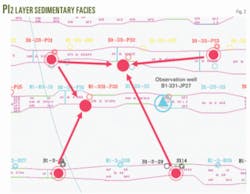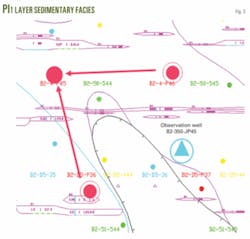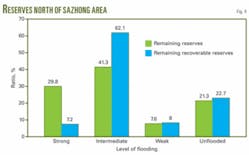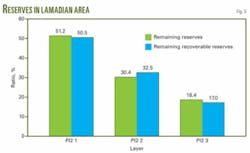At present, one potential for additional oil recovery from Daqing oil field in northern China is the remaining oil contained in reservoirs that have undergone polymer flooding.
The first field-scale polymer flooding at Daqing started in 1996, and polymer flooding has shown good technical and economic results.
By November 2007, Daqing already had 14 areas in which polymer injection had finished. These 14 areas have more than 2,000 production and injection wells.
Oil recovery after polymer flooding from these areas is 52.8%, meaning that the areas still contain large amounts of crude oil.
Determining the distribution of the remaining oil is the key for tapping this potential source of oil.
Remaining oil
One factor affecting oil recover at Daqing is the cyclic sedimentation of the reservoirs.
Small quantities of oil remain in the upper parts of the sections of the first class, connected, river-channel sand. The polymer flooding was effective in these sands, and a high proportion of the thickness was flooded. There remains, however, some untapped oil. The oil mainly is in the upper part of the section that has poor physical properties.
The remaining oil also has a scattered distribution.
The field has 29 sedimentary units with remaining oil. These units have a total effective thickness of 147.6 m with a weakly flooded and unflooded thickness of 21.4 m or 14%.
Fig. 1 shows that the unflooded thickness of the PI2 unit in the observation well L6-J2331 is 2.05 m, including four isolated intervals that interlace with intermediate-flooded intervals. The unflooded thickness in the PI 2 unit from observation well L6-J2334 is 1.30 m. This includes three isolated intervals that have different distributions in other parts of the waterflood.
The remaining oil has a fragmented distribution.
Most unflooded intervals are in areas with poor physical properties. The intervals have less than a 0.6 md air permeability. The average is 0.19 md, meaning that the intervals require suitable stimulation to displace the remaining oil.
Another factor affecting oil recovery is the poor connectivity between the channel sands.
Where nonriver-channel sand exists between injection and producing well, the area will have relatively low oil recovery.
Twelve sedimentary units contain this kind of remaining oil. The units have a total effective thickness of 24.6 m and a 10.05 m (40.8%) weakly flooded and unflooded thickness. As an example in the PI2 unit of observation well B1-331-JP27, the injection well is in main body, thin sand while the producing well is in a river-channel sand. The distance between the wells is large. The layer has a 3.72 m effective thickness with a 1.88 m (55.5%) weakly flooded and unflooded thickness (Fig. 2).
A third factor affecting oil recovery is incomplete injection-production patterns.
Some intervals in the injection-production well pattern are incomplete and have much remaining oil. Four layer units have this kind of remaining oil. The units have a 14.95 m effective thickness of which 10.63 m (71.1%) is weakly flooded and unflooded. An example is the PI1 unit of observation well B2-350-J45. The well is at the peripheral part of interriver sand and all of its 0.93 m effective thickness is unflooded (Fig. 3).
A fourth factor affecting recovery is that some oil remains in areas that have branch streamlines in the original well pattern for polymer flooding
In 2007, two observation wells were drilled in the same well group in the B-2 area of the north Saertu oil area. The wells are B2-322-JP43 (main streamline) and B2-323-JP42 (branch streamline). Table 1 compares the streamlines.
Most of the reservoir on the main streamline area was strongly waterflooded. This area has a thickness ratio that is 17.3% larger than the area with the branch streamlines. On the other hand, most of reservoir on the branch streamlines was waterflooded intermediately. This area has a thickness ratio that is 14.3% larger than that main streamline area.
The ratio of unflooded thickness in the branch streamline area is 3.8% less than in the main streamline area.
The comparison of log interpretations shows that for the PI layer unit after polymer flooding, the remaining oil in the branch streamline area is much higher than in the main streamline area (Table 2). The water saturation in the area with branch streamlines is 5.77% lower than in the main streamline area after polymer flooding for the PI1-4 units.
Remaining oil also exists near the production well of the original polymer-flood well pattern.
The analysis of data in October 2005 from two cored wells at different points along the injection-production main streamline in the west block of the northern Lamadian oil area show this. Observation well L6-J2331, about 160 m away from the injection well, indicated an oil recovery factor of only 43%, but another observation well L6-J2334, 80 m away from injection well, indicated an oil recovery factor of 54.3%, 12% higher than in the L6-2331 well (Table 3).
Although river-channel sands are in all PI21, PI22, and PI23 layers, their distances to the injection well are different; and therefore the three layers exhibit different oil recoveries in the observation wells.
Potential after polymer flooding
According to data from 11 observation wells, after polymer flooding, the remaining potential is mainly in the intermediately and strongly flooded intervals that account for 71.1% of the total remaining reserves (Fig. 4).
If the displacement efficiency of strongly flushed intervals remains unchanged while the displacement efficiency of other intervals increases to the average value of the higher flooded levels, the resulting remaining oil in the strongly, intermediately, weakly, and unflooded intervals is 7.2%, 62.1%, 8.0%, and 22.7%, respectively.
After polymer flooding, the focus will be on improving the recovery efficiency of the intermediately flooded intervals in thick pay zones. The major pay zones with remaining reserves are in the PI2 and PI3 sedimentary units in which the river-sands are well developed.
The oil layers of the PI2 unit in the Lamadian area are braided river sediments.
The distribution of remaining reserves is 50.5% in PI21, 32.3% in PI22 unit, and only 17% in PI23 due to the thinness (Fig. 5).
Sazhong and Saibei areas also show the same potential remaining oil distribution.
Some of the possible measures to enhance oil recovery after polymer flooding include surfactant flooding, surfactant-polymer binary flooding, alkaline-surfactant-polymer ternary flooding, high concentration polymer flooding, microbial oil recovery, fracturing, profile control, water shutoff, adjustment of well pattern, thermal recovery technique, horizontal well technique, and combination of these measures.
Daqing oil field has seen good results for oil recovery after polymer flooding.
Acknowledgment
The National Natural Science Foundation of China under Grant No. 50634020 supported work described in this article.
References
The authors
Zhang Ji-Cheng ([email protected]) is an associate professor in the petroleum engineering department, Daqing Petroleum Institute, Daqing, China. His focus is in research for oil and gas field development.
Song Kao-Ping is professor in the petroleum engineering department, Daqing Petroleum Institute, Daqing, China. His focus is in research for oil and gas field development.
